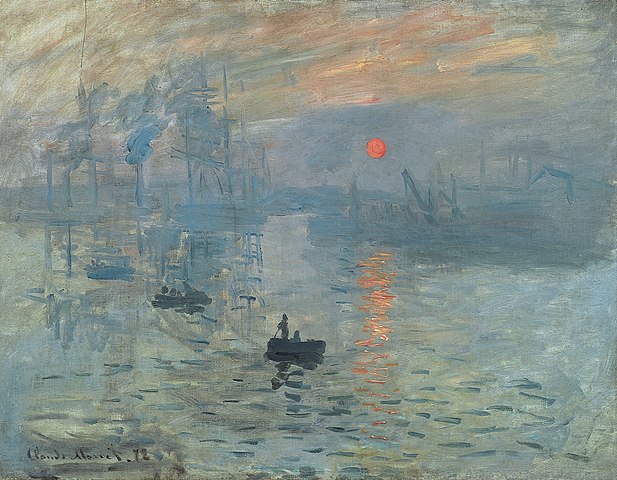Claude Monet’s painting “Impression, Sunrise,” created in 1872, is one of the most iconic works of the Impressionist movement. It is famous for its hazy, almost abstract depiction of a sunrise over the port of Le Havre in France. While it may seem to lack overt symbolism compared to other artworks, “Impression, Sunrise” is rich in symbolism in its own right:
Impressionism:
The painting is often considered the namesake of the Impressionist movement. The term “Impressionism” itself was derived from the title of this artwork. Monet’s intention with this painting was not to create a detailed, precise representation of the scene but to capture the “impression” or fleeting moment of light and atmosphere. In this sense, the artwork symbolizes a shift away from the meticulous, realistic style of earlier art movements.
Light and Atmosphere:
Monet’s use of color, light, and brushwork in “Impression, Sunrise” symbolizes his fascination with the effects of light and atmosphere on a scene. The sunrise, with its hazy light and diffuse reflection on the water, becomes a symbol of the transitory nature of moments in time and the play of light over the landscape.
Industrialization:
The depiction of the industrial port in the background, with its silhouette of steamboats and smokestacks, can be seen as a symbolic representation of the rapid industrialization of the 19th century. It reflects the encroachment of industry and modernity on the natural landscape, a theme that concerned many Impressionist artists.
Nature vs. Industry:
The juxtaposition of the natural elements (sun, water, and sky) with the industrial elements (boats, factories, and smoke) can be seen as a symbol of the tension between nature and industry. This was a significant cultural and environmental concern of the time, as the industrial revolution brought changes to the natural world.
Atmospheric Transience:
The hazy and almost dreamlike quality of the painting can be seen as a symbol of the fleeting and transient nature of reality. It captures the idea that moments, like the play of light on water, are ephemeral and can never be exactly replicated.
Rejection of Conventions:
The Impressionists, including Monet, rejected the conventional artistic norms of the time, including realistic representation and academic styles. “Impression, Sunrise” symbolizes a break from tradition and a bold step into a new artistic paradigm that emphasized individual expression and the artist’s perception of a scene.
Subjective Experience:
Monet’s use of color and brushwork allows viewers to engage with the painting on a personal and subjective level. The viewer’s own experiences and emotions can be brought to the forefront when interpreting the painting, symbolizing the idea that art is a subjective experience.
In summary, “Impression, Sunrise” by Claude Monet may not have overt symbols in the traditional sense, but it is deeply symbolic of the Impressionist movement and the artist’s exploration of light, atmosphere, and the shifting nature of reality. It embodies a rejection of artistic conventions, a reflection of industrialization, and a celebration of the subjective experience of art. It remains a significant and influential work in the history of art.










